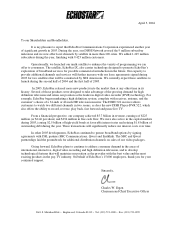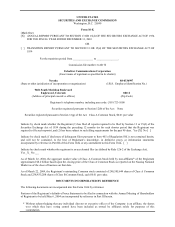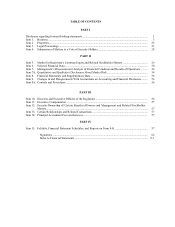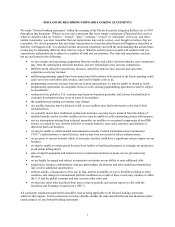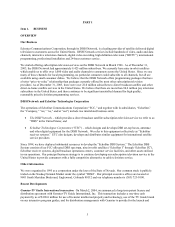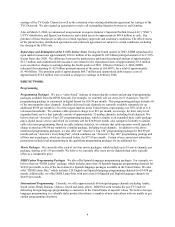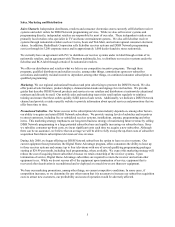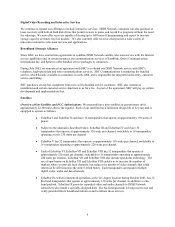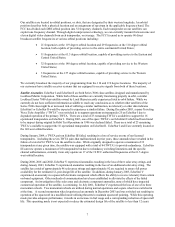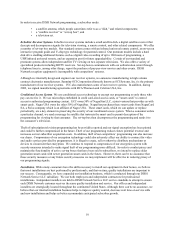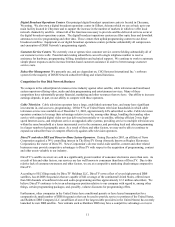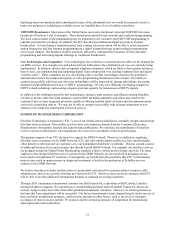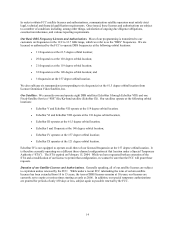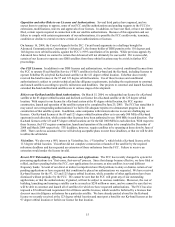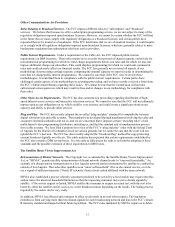Dish Network 2003 Annual Report Download - page 12
Download and view the complete annual report
Please find page 12 of the 2003 Dish Network annual report below. You can navigate through the pages in the report by either clicking on the pages listed below, or by using the keyword search tool below to find specific information within the annual report.7
Our satellites are located in orbital positions, or slots, that are designated by their western longitude. An orbital
position describes both a physical location and an assignment of spectrum in the applicable frequency band. The
FCC has divided each DBS orbital position into 32 frequency channels. Each transponder on our satellites can
exploit one frequency channel. Through digital compression technology, we can currently transmit between nine and
eleven digital video channels from each transponder, on average. The FCC licensed us to operate 96 direct
broadcast satellite frequencies at various orbital positions including:
• 21 frequencies at the 119 degree orbital location and 29 frequencies at the 110 degree orbital
location, both capable of providing service to the entire continental United States;
• 11 frequencies at the 61.5 degree orbital location, capable of providing service to the Eastern and
Central United States;
• 32 frequencies at the 148 degree orbital location, capable of providing service to the Western
United States;
• 3 frequencies at the 157 degree orbital location, capable of providing service to the Western
United States.
We currently broadcast the majority of our programming from the 110 and 119 degree locations. The majority of
our customers have satellite receiver systems that are equipped to receive signals from both of these locations.
Satellite Anomalies. EchoStar I and EchoStar II are both Series 7000 class satellites designed and manufactured by
Lockheed Martin Corporation. While both of those satellites are currently functioning properly in orbit, a similar
Lockheed Series 7000 class satellite owned by Loral Skynet recently experienced total in-orbit failure. While we
currently do not have sufficient information available to reach any conclusions as to whether other satellites of the
Series 7000 class might be at increased risk of suffering a similar malfunction, no telemetry or other data indicates
EchoStar I or EchoStar II would be expected to experience a similar failure. During December 2003, a spare Traveling
Wave Tube Amplifier (“TWTA”) was switched in to support operations on transponder 25 on EchoStar I due to
degraded operation of the primary TWTA. There are a total of 23 remaining TWTA’s available to support the 16
operational transponders on EchoStar I. During 2003, one of the spare TWTA’s on EchoStar II which had been found
to be suspect during original In Orbit Test Operations in 1996 was declared failed. There are a total of 23 remaining
TWTA’s available to support the 16 operational transponders on EchoStar II. EchoStar I and II are currently located at
the 148 west orbital location.
During January 2004, a TWTA pair on EchoStar III failed, resulting in a loss of service on one of our licensed
transponders. Including the seven TWTA pairs that malfunctioned in prior years, these anomalies have resulted in the
failure of a total of 16 TWTA’s on the satellite to date. While originally designed to operate a maximum of 32
transponders at any given time, the satellite was equipped with a total of 44 TWTA’s to provide redundancy. EchoStar
III can now operate a maximum of 28 transponders but due to redundancy switching limitations and the specific
channel authorizations, currently it can only operate on 17 of the 19 FCC authorized frequencies at the 61.5 degree
west orbital location.
During 2000, 2001 and 2002, EchoStar V experienced anomalies resulting in the loss of three solar array strings, and
during January 2003, EchoStar V experienced anomalies resulting in the loss of an additional solar array string. The
satellite has a total of approximately 96 solar array strings and approximately 92 are required to assure full power
availability for the estimated 12-year design life of the satellite. In addition, during January 2003, EchoStar V
experienced an anomaly in a spacecraft electronic component which affects the ability to receive telemetry from certain
on-board equipment. Other methods of communication have been established to alleviate the effects of the failed
component. An investigation of the solar array and electronic component anomalies, none of which have impacted
commercial operation of the satellite, is continuing. In July 2001, EchoStar V experienced the loss of one of its three
momentum wheels. Two momentum wheels are utilized during normal operations and a spare wheel was switched in
at the time. A second momentum wheel experienced an anomaly in December 2003 and was switched out resulting in
operation of the spacecraft in a modified mode utilizing thrusters to maintain spacecraft pointing. While this operating
mode provides adequate performance, it results in an increase in fuel usage and a corresponding reduction of spacecraft
life. This operating mode is not expected to reduce the estimated design life of the satellite to less than 12 years.


